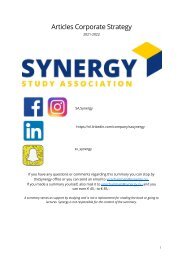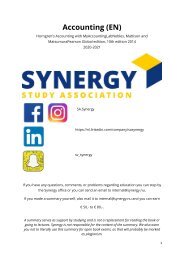You also want an ePaper? Increase the reach of your titles
YUMPU automatically turns print PDFs into web optimized ePapers that Google loves.
Net income earned by the investee is not a proper basis for recognizing income from the<br />
investment by the investor. The investor earns net income only when the investee declares cash<br />
dividends.<br />
Significant influence may be indicated in several ways. Examples include representation on the<br />
board of directors, participation in policy-making processes, material intercompany transactions,<br />
interchange of managerial personnel, or technological dependency. Another important<br />
consideration is the extent of ownership by an investor in relation to the concentration of other<br />
shareholdings.<br />
Under the equity method, the investor <strong>and</strong> the investee acknowledge a substantive economic<br />
relationship. The investor’s proportionate share o the earnings (losses) of the investee<br />
periodically increases (decreases) the investment’s carrying amount. All dividends received by the<br />
investor from the investee also decreases the investment’s carrying amount.<br />
Using dividends as a basis for recognizing income fails to report properly the economics of the<br />
situation.<br />
When one corporation acquires a voting interest of more than 50 percent in another corporation,<br />
it is said to have a controlling interest. In such a relationship, the investor corporation is referred<br />
to as the parent <strong>and</strong> the investee corporation as the subsidiary. When the parent treats the<br />
subsidiary as an investment, the parent generally prepares consolidated financial statements.<br />
We have identified the basic issues involved in accounting for investments in debt <strong>and</strong> equity<br />
securities. In addition, the following issues relate to the accounting for investments:<br />
1. Impairment of value → A company should evaluate every held-for-collection investments, at<br />
each reporting date, to determine if it has suffered impairment – a loss in value such that the fair<br />
value of the investment is below its carrying value. If the company determines that an investment<br />
is impaired, it writes down the amortized cost basis of the individual security to reflect this loss in<br />
value. If an investment is impaired, the company should measure the loss due to the impairment.<br />
This impairment loss is calculated as the difference between the carrying amount plus accrued<br />
interest <strong>and</strong> the expected future cash flows discounted at the investment’s historical effectiveinterest<br />
rate.<br />
2. Transfers between categories<br />
Chapter 19 – <strong>Accounting</strong> for Income Taxes<br />
Pretax financial income is a financial reporting item. It also is often referred to as income before<br />
taxes, income for financial reporting purposes, or income for book purposes. Taxable income is a<br />
tax accounting term. It indicates the amount used to compute income taxes payable. Companies<br />
determine taxable income according to the tax regulations. Income taxes provide money to<br />
support government operations.<br />
A temporary difference is the difference between the tax basis of an asset or liability <strong>and</strong> its<br />
reported amount in the financial statements, which will result in taxable amounts or deductible<br />
amounts in future years. Taxable amounts increase taxable income in future years. Deductible<br />
amounts decrease taxable income in future years.<br />
A deferred tax liability is the deferred tax consequences attributable to taxable temporary<br />
differences. In other words, a deferred tax liability represents the increase in tax payable in<br />
future years as a result of taxable temporary differences existing at the end of the current year.<br />
Current tax expense → the amount of income taxes payable for the period. Deferred tax expense<br />
is the increase in the deferred tax liability balance from the beginning to the end of the<br />
accounting period.<br />
One objective of accounting for income taxes is to recognize the amount of taxes payable or<br />
38
















